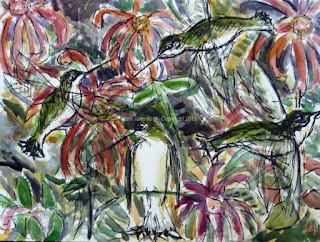 |
| Ruby-throated Hummingbird on Monarda in Backyard. Sumi Brush Pen and Watercolor by Ken Januski. |
I always feel a bit guilty showing work of mine that is largely based on photos. That's because I'm so critical of art based on photos. That was the case with the Killdeer in my last post. The more I've painted though, especially since I turned from abstraction to naturalism the more I realize that photos aren't anathema. They're just very dangerous.
But I think it would be safe to say that the vast majority of people who look at my work, or most art, are very partial to work that looks like a photo. And that's why I'm so adamantly against it. The general populace now gauges reality through photos, even though they are very limited and show only one aspect of objects portrayed.
Still I use them occasionally because they help me to remember all the details that I often can't seem to force into my memory. In that sense they are a useful aid to memory(aide memoire).
More often though I'd like to portray the experience of something. If you've ever seen a Ruby-throated Hummingbird you probably realize that they rarely sit still. They are always moving, well almost always. And the movement is more emblematic of them than those rare times when they perch.
So the 12x16 watercolor above is done strictly from memory. I've looked at the Ruby-throated Hummingbirds in our yard a lot over the last few summers. That doesn't mean that I also haven't missed a lot. But I wanted to do something spontaneous that was based on my memory of them and of the Monarda on which they often feed. The painting above is meant to render just one hummingbird, not a number of them. And within a few seconds just one hummingbird will have been in that many different positions.
So which is more 'real', the painting above, or one that captures every iridescent feather in a sitting bird that looks like it's been stuffed?
As I started to write this brief post I was going to stick to the dichotomy between rendering an experience and rendering a photo. But I realized that there is also a third alternative and that is the picture postcard. It is more like a picturesque rendering of a scene, relying more on sentimental formula than anything else. I don't see that much of this sort of art, but I'm sure that's only because I try to steer clear of places that concentrate on cute art. Still it is one of the other ways in which artists try to portray what they see, especially in terms of birds and wildlife.




















